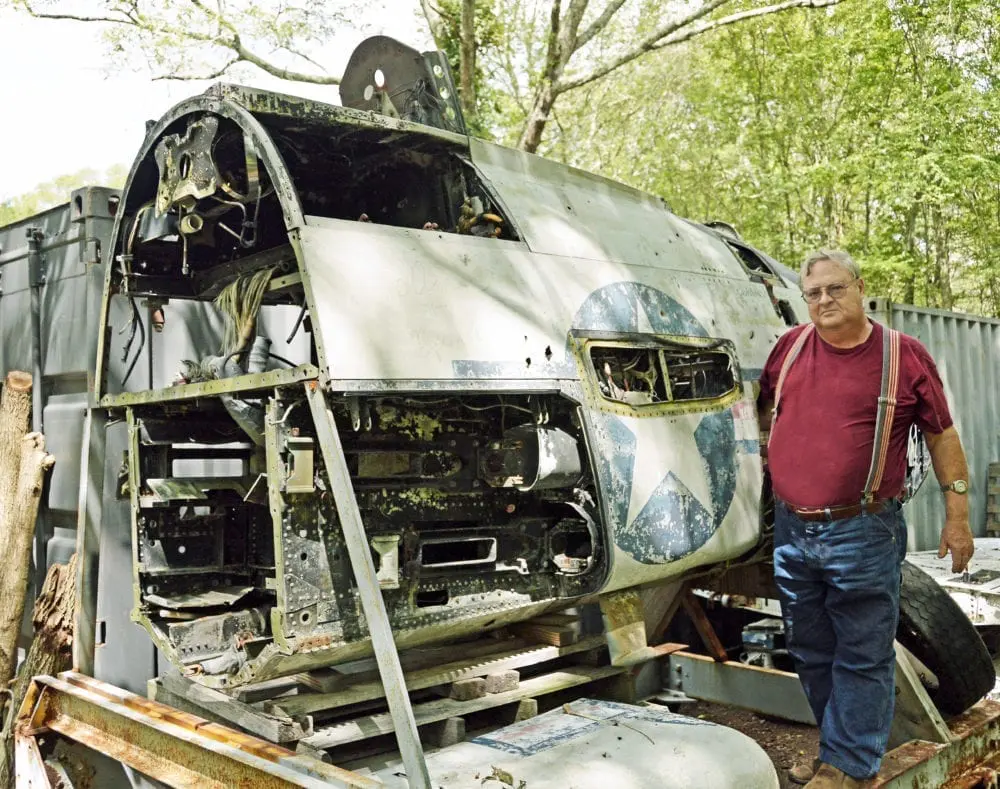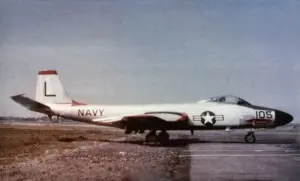Larry Webster was standing out behind his barn in Charlestown, Rhode Island next to the remains of a large corroded Korean War vintage aircraft. The aircraft was a Banshee , an early twin engine jet fighter. The aircraft’s fuselage, engine, wings and other large parts were stacked up in piles behind us. Larry pointed to the faded lettering of a name on the side of what once had been the cockpit; it read “Lt jg J.P. Zebrowsky.”
Larry said he plans to restore the aircraft and change the markings to “Lieutenant JG Jack Oliver Snipes.” I wondered why a 70-year-old retired mechanical engineer would want to restore an old fighter jet and put the name of a pilot on it that had died in 1953.
Larry pointed out pieces of other aircraft sticking up through the briers; here was a cockpit from a Hellcat, and there was a propeller from a lost B-24 Bomber. Each piece had a story that in many cases represented the end of a young man’s life in the ultimate sacrifice for their country. Lieutenant Snipes was one of them.
He had been killed on June 24, 1953 in a training mission in a mid-air collision with another Banshee in West Greenwich. Larry told me: “I have his ejection seat here and some pieces from his aircraft and his spirit is still out here. So I thought it would be fitting for a number of reasons to honor him.”
Larry wanted to become a pilot but poor eyesight prevented it so he went on to study engineering at the University of Rhode Island, graduating in 1969. Larry became an award winning mechanical engineer working for Browne & Sharpe and later for Heidelberg-Harris in Pawcatuck, Conn. for 23 years. During this time he continued to excavate crash sites and became a dedicated aircraft wreck hunter and nationally recognized for his aircraft restoration work.
This included the complete restoration of a F6F-5 Hellcat for the New England Air Museum, a monumental task that took him 18 years. He received the Northeast Aero Historians award in 2004 and in 2013 was inducted into the Rhode Island Aviation Hall of Fame. Locally Larry helped establish a memorial to the 62 pilots who died during training at the abandoned Charlestown Naval Air Station.
We continued down a wooded path with more than a 100 thousand pounds of aircraft wreckage piled on either side. Larry explained that he’d been fascinated by the story each piece of wreckage could tell about the thousands pilots who’d perished nationwide in these accidents. These airmen are the little known heroes of World War II and the Korean War that had been killed; not overseas in combat but in this country training for combat. Their stories and the sacrifices they made are almost totally forgotten. Larry’s goal is to be able to tell some of their stories.
“In the World War II there were between 60 and 80 thousand aviation fatalities in both the Army Air Corp and Navy and a large number of them were from training in the US,” he said. “There were probably 500 here in Rhode Island flying out of these bases alone.”
I was astounded by the large number. He suggested that I contact Ted Darcy of the FWI Research Group in Washington DC. The Group is dedicated to the goal of the compilation and preservation of World War II records. I called them and spoke with Ted Darcy and he told me that in World War II there were 79,804 total aviation fatalities. Of those 19,746 occurred during training.
“Surprisingly the Navy left many bits and pieces of airplanes out in the woods. The very first one I visited was this heap right here.” Larry said as he pointed to a pile of wreckage by the side of a path. “This is the remains of a F6F Hellcat that crashed over at Camp Jori on mother’s day 1944. It had been practicing bombing targets in Worden Pond; that crash killed the pilot and his spirit is out here.”
Larry’s mother, Elsa Webster, had witnessed that crash. It happened on the Streeter Farm less than a mile away from them. Elsa felt the impact and saw black smoke swirling up through the trees. By the time she got to the farm the adjacent woods were still smoldering. Elsa started to walk toward the wreckage but stopped when bits of the pilot became visible. Later, some Navy men came and collected two 10-quart milk pails of the remains of the pilot, 22-year-old Ensign James Gannon.
Elsa never forgot the crash and over the years spoke of it many times. In the summer of 1961, her then teenage son, Larry, set out to find the crash site. Young Larry found the wreckage and started digging. First he found the Hellcat’s large engine, 12-feet long, still stuck in the crater it had created in the ground. Digging deeper he came upon some bones. They were some of the remains of Ensign James Gannon that the Navy had not found. Surprised but excited Larry gathered all the remains and the young Ensign’s remains were later given a burial by a local farmer.
Larry told me that at least 50 planes had crashed within a 10-mile radius of their farm because of its proximity to all the naval training bases. Over the years much of the metal from all these sites was salvaged by scavengers and hauled away to be sold as scrap. The few attempts to salvage war time wrecks for preservation have met with resistance from the Navy and recently a law was passed making it illegal to salvage anything from military wrecks.
Larry thinks the reason is that this bit of history is messy.
“The Navy does not want to allow the recovery of wreckage,” he said. “I think they know how messy and sloppy they were in recovering bodies because there were so many fatal accidents around here. They happened so often that they had crews out on a continual basis.”
Larry stopped by a piece of wreckage.
“This is the actual seat that Lieutenant JG Jack Oliver Snipes was in when he died,” he said.
I was looking at a piece of wreckage that to me only vaguely resembled a seat. It had fallen 19,000 feet out of a burning airplane with Jack Snipes still strapped into it. The night of the crash Snipes and Ensign J.J. Schollian, the other pilot, were on a training mission. Snipes came up under and collided with Schollian’s Banshee. Both planes burst into flame and plummeted toward the earth, Snipes was killed instantly. Schollian tried to eject but his seat didn’t work. He struggled to open his canopy, unstrapped his harness and bailed out. Somehow, miraculously, he survived with only minor injuries. Snipes and his whole seat assembly landed out in the woods miles away. Larry explained how he got it.
“They found his seat with him in it three days later out in West Greenwich,” Larry said. “Years later a farmer out in Exeter had the seat and he gave it to me.”
I asked Larry about the stories of ghosts haunting the wreckage.
“So this seat that Snipes died in out here has his spirit attached to it,” he said. “It turns out quite a few other people, not me, have seen his ghost out here. He appears as a spirit, a ghost from the knees up. He has a very distinctive top. One person who saw him said he had an elephant nose on him which would have been his oxygen mask. Another person was here and said they heard Snipes say, ‘tell my story, tell my story.’ That was what she was hearing from him. That’s another reason why I consider it my little mission to collect this stuff, to tell his story.”
“I now have the history of Snipes, everything about him. He was born October 21, 1928 in Greensboro, North Carolina to itinerant workers. They were very poor. He went from not having a high school diploma to becoming a decorated Lieutenant JG fighting in the Korean War,” Larry continued. “He fought combat in Korea in F9F Panthers which is a similar aircraft to the Banshee. He flew over 40 combat missions in Korea. He was awarded the Navy Unit Commendation and permanent citations for the Air Metal and Gold Star in lieu of the Second Air Metal. When he came back to Quonset they changed over to the Banshee an all-weather night fighter. He was back here for only a few months before he got killed. So it’s a rags to riches story. For him to come all the way from poverty to flying a Navy jet and being decorated in the Korean War is remarkable. He was buried in Grove, North Carolina next to his father.”
We walked back to the Banshee and I asked Larry how he got the plane? He told me that sfter it was retired from the Navy in 1960 it sat at the Harbor Airport in Greensboro, North Carolina until 1975.
“Leon Cleaver rescued this airplane and he brought it up to Ohio and it sat there outside for forty years. That’s why a lot of this steel is all rusted,” Larry said. “While it was in North Carolina the local police department and hunters down there used it for target practice. So you can see bullet holes all over the place. Finding a Banshee was one of my Holy Grails. I paid $2,000 for the plane and $8,000 to have it taken apart and brought up here 2010.”
I wondered how long it would take Larry to restore this aircraft. He said he didn’t think he was going to live long enough to finish it as it’s a huge project.
“I want to do an external restoration in a bare metal version with Jack Oliver Snipes’ markings,” he said. “I don’t have a place to display it yet. Once we get to that point we’ll find a home here in Rhode Island somewhere but with the current mode in the state now who knows.”
“There are probably parts from up to 60 aircraft back here. Some of them, just lunch bag amounts and others some pretty substantial wreckage and every one of them has a story.” Perhaps the spirit of Lieutenant Jack Oliver Snipes and the souls of the other men who haunt this wreckage can find peace when their stories are told and the honor that is due them is bestowed. Larry, for one, will not forget them.










